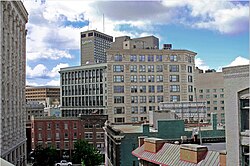Exchange District
| Exchange District | |
|---|---|

Buildings in Winnipeg's Exchange District
|
|
| Location | Winnipeg, Manitoba, Canada |
| Founded | 1881 |
| Website | www |
The Exchange District is a National Historic Site of Canada in the downtown area of Winnipeg, Manitoba, Canada. Just one block north of Portage and Main, the Exchange District comprises twenty city blocks and approximately 150 heritage buildings, and it is known for its intact early 20th century collection of warehouses, financial institutions, and early terra cotta clad skyscrapers.
The Exchange District’s name originates from the Winnipeg Grain Exchange, the former centre of the grain industry in Canada, as well as other commodity exchanges which developed in Winnipeg between 1881–1918, some of which are still active today. (see Winnipeg Commodity Exchange)
Winnipeg was one of the fastest growing cities in North America around the turn of the 20th century. The city became known as the Chicago of the North. Much of Winnipeg’s remaining architecture of the late 1800s and early 1900s is heavily influenced by the Chicago style. By 1911, Winnipeg had become the third largest city in Canada. At the time it had more than two dozen rail lines converging near the city center along with over 200 wholesale businesses.
World War I and the opening of the Panama Canal in 1913 slowed Winnipeg's growth, as there was a new route for shipping goods from Eastern Canada and Europe to Western Canada and from East Asia to the larger markets on the Eastern seaboard. After this period much of Winnipeg’s development shifted to Portage Avenue and streets to the south like Broadway and on towards Osborne Village - the stagnant growth of the Exchange District meant that few buildings were demolished in the subsequent decades. As a result, Winnipeg has one of the most historically intact early 20th century commercial districts in North America.
...
Wikipedia
